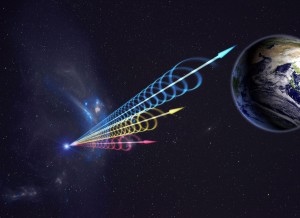New Light Shed on the Fast Radio Burst Mystery

Artist impression of a Fast Radio Burst (FRB) reaching Earth. The colours represent the burst arriving at different radio wavelengths, with long wavelengths (red) arriving several seconds after short wavelengths (blue). This delay is called dispersion and occurs when radio waves travel through cosmic plasma.
Credit: Jingchuan Yu, Beijing Planetarium
NRAO Fast Radio Burst Press Release Video from NRAO Outreach on Vimeo.
Kiyoshi Masui speaks to Nature Podcast about the team’s recent findings.
A team of astronomers, led by the former CITA graduate student Kiyoshi Masui, and including current CITA professor Ue-Li Pen, have uncovered the most detailed record of a Fast Radio Burst (FRB) yet. These elusive FRBs are energetic bursts of cosmic radio waves that have been difficult to detect and even more difficult to characterize due to their unknown origin.
In the recent study published in Nature, the team sifted through 40 terabytes of data from National Science Foundation’s (NSF) Green Bank Telescope (GBT) by using special analysis techniques that yielded the cleanest, least distorted FRB to date.
The impact of the results is several-fold. Masui explains, “Taken together, these remarkable data reveal more about an FRB than we have ever seen before and give us important constraints on these mysterious events.” He adds, “We also have an exciting new tool to search through otherwise overwhelming archival data to uncover more examples and get closer to truly understanding their nature.” Additionally, “This new discovery was enabled by the repeated perseverance of this team to again overcome what was previously perceived as futile, and is already impacting the mission of the new telescopes,” says Ue-Li Pen.
The story has been broadly covered by various international media platforms.
The National Radio Astronomy Observatory press release can be found here.